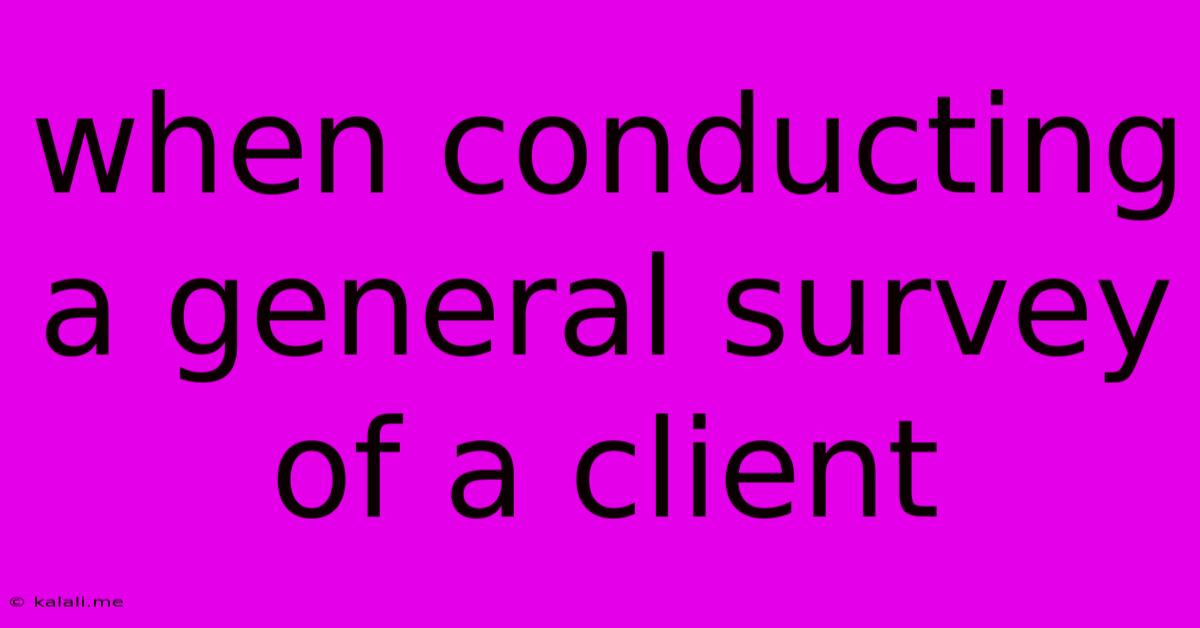When Conducting A General Survey Of A Client
Kalali
Jun 15, 2025 · 4 min read

Table of Contents
Conducting a General Client Survey: A Comprehensive Guide
Meta Description: Learn how to conduct effective general client surveys to gather valuable feedback, improve services, and boost client satisfaction. This guide covers everything from planning and designing your survey to analyzing results and taking action.
Conducting a general client survey is a crucial step in understanding your client's needs and improving your business. It provides invaluable insights into client satisfaction, identifies areas for improvement, and ultimately helps you build stronger, more profitable relationships. However, a poorly designed or executed survey can yield useless data. This guide will walk you through the process of creating and implementing a successful general client survey.
Phase 1: Planning Your Client Survey
Before you even start crafting questions, meticulous planning is key. This phase involves defining your objectives, target audience, and the best method for collecting responses.
-
Define Your Objectives: What specific information are you hoping to gain? Are you looking to measure overall satisfaction, identify pain points in your service delivery, or gather suggestions for new features? Clearly defined objectives will guide your question selection and analysis. Examples include: gauging customer loyalty, understanding areas needing improvement, or measuring customer perception of value.
-
Identify Your Target Audience: Who are you surveying? Segmenting your audience (e.g., by demographics, service usage, or purchase history) allows for more targeted analysis and tailored improvements. Understanding your audience will help you tailor language and question types.
-
Choose Your Survey Method: Several methods exist, each with advantages and disadvantages:
- Online Surveys (e.g., using SurveyMonkey, Google Forms): Cost-effective, easy to distribute widely, and allows for automated data analysis.
- Email Surveys: Simple to send, but response rates can be lower.
- Phone Surveys: Allows for more in-depth questioning and clarification, but can be time-consuming and expensive.
- In-Person Surveys: Provides the highest response rate and allows for immediate feedback, but is the most time-consuming and expensive.
-
Determine Sample Size: A larger sample size generally provides more statistically significant results, but also requires more resources. Use a sample size calculator to determine an appropriate number of respondents based on your target population and desired confidence level.
Phase 2: Designing Your Client Survey
The design of your survey is crucial for obtaining accurate and meaningful data. Focus on creating clear, concise, and unbiased questions.
-
Question Types: Utilize a mix of question types to gather diverse information:
- Multiple Choice: Easy to analyze and provides clear-cut answers.
- Rating Scales (e.g., Likert scales): Measures opinions and attitudes on a scale (e.g., 1-5 stars).
- Open-Ended Questions: Allows for qualitative feedback and deeper insights, but requires more time to analyze.
- Demographic Questions: Gather essential information about your respondents (age, location, etc.) to segment your data for more detailed analysis.
-
Keep it Concise: Long surveys lead to lower completion rates. Aim for brevity while ensuring you gather all the necessary information.
-
Use Clear and Simple Language: Avoid jargon or technical terms that your clients may not understand.
-
Pilot Test: Before launching your survey to a wider audience, test it on a small group to identify any issues with clarity or flow.
Phase 3: Implementing and Analyzing Your Client Survey
This phase involves distributing your survey, collecting responses, and analyzing the data to draw meaningful conclusions.
-
Distribution: Choose the appropriate method based on your target audience and chosen survey method. Consider offering incentives (e.g., discounts, giveaways) to increase response rates.
-
Data Collection: Ensure you have a system in place to track responses and maintain data integrity.
-
Data Analysis: Use appropriate statistical methods to analyze your data. Identify trends, patterns, and key insights that inform your strategic decision-making. Pay close attention to both quantitative (numerical) and qualitative (textual) data.
-
Reporting: Summarize your findings in a clear and concise report, highlighting key insights and actionable recommendations. Use charts and graphs to visually represent your data.
Phase 4: Taking Action Based on Your Findings
The final and most crucial step is acting on the insights gained from your survey.
-
Prioritize Improvements: Focus on addressing the most pressing issues and opportunities revealed in your analysis.
-
Implement Changes: Make necessary adjustments to your products, services, or processes based on client feedback.
-
Communicate with Clients: Let your clients know that you've heard their feedback and are taking action. This demonstrates your commitment to improving their experience.
-
Monitor Progress: Track the impact of your changes and continue to monitor client satisfaction over time. Consider conducting follow-up surveys to assess the effectiveness of your improvements.
By following these steps, you can conduct a general client survey that yields valuable insights, enhances client relationships, and drives business growth. Remember, the key is to plan carefully, design effectively, analyze thoroughly, and act decisively. This iterative process will contribute to continuous improvement and enhance the overall success of your business.
Latest Posts
Latest Posts
-
Which Of The Following Examples Is Inclusive
Jun 15, 2025
-
Which Statement Is True Concerning Blood Cells
Jun 15, 2025
-
Measurement Of Badminton Court For Doubles
Jun 15, 2025
-
Which Of These Substances Is A Compound
Jun 15, 2025
-
Lcm Of 12 4 And 8
Jun 15, 2025
Related Post
Thank you for visiting our website which covers about When Conducting A General Survey Of A Client . We hope the information provided has been useful to you. Feel free to contact us if you have any questions or need further assistance. See you next time and don't miss to bookmark.